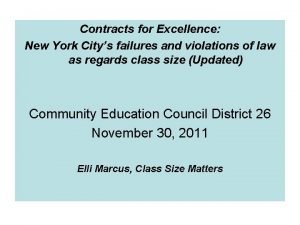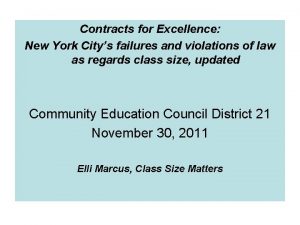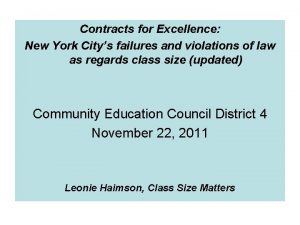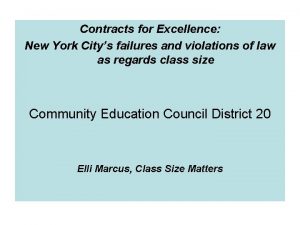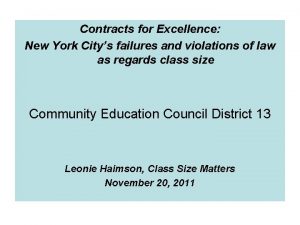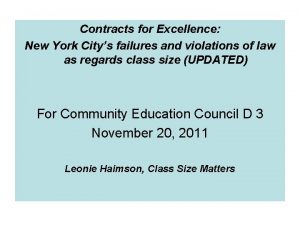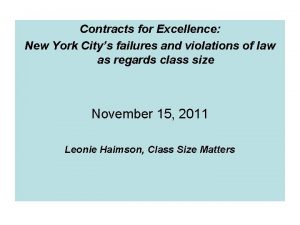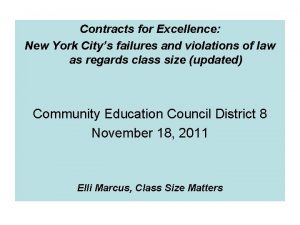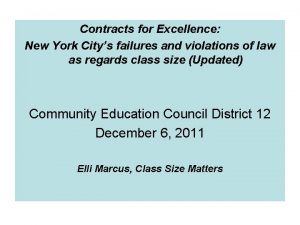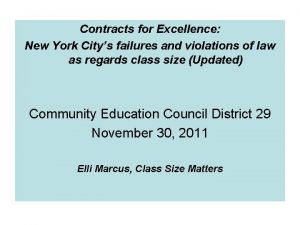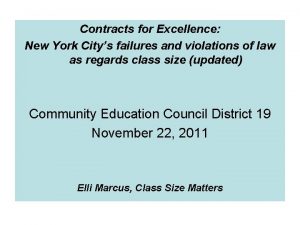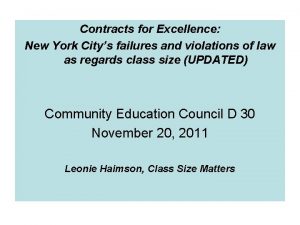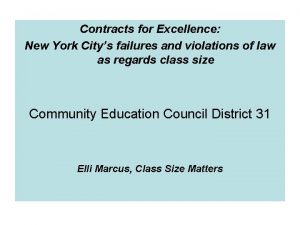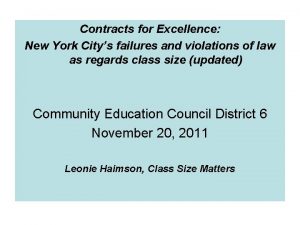Contracts for Excellence New York Citys failures and


















- Slides: 18

Contracts for Excellence: New York City’s failures and violations of law as regards class size (updated) Community Education Council District 6 November 20, 2011 Leonie Haimson, Class Size Matters

Why is class size important? • Class size reduction one of 4 reforms proven to work through rigorous evidence, acc. to Inst. Education Sciences, research arm of US Ed Dept. * • Benefits especially large for disadvantaged & minority students, very effective at narrowing the achievement gap. • NYC schools have largest class sizes in state; in 2003, NY’s highest court said students denied constitutional right to adequate education as a result of excessive class sizes (Campaign for Fiscal Equity decision). • 86% of NYC principals say cannot provide a quality education because of excessive class sizes. • Smaller classes are top priority of parents on DOE learning environment surveys every year. • *Other three K-12 evidence-based reforms, are one-on-one tutoring by qualified tutors for at-risk readers in grades 1 -3, Life-Skills training for junior high students, and instruction for early readers in phonemic awareness and phonics.

Despite claims of administration, stagnant achievement in NYC schools since Bloomberg elected • Over the last 8 yrs. , NYC black & Hispanic students fallen further behind their peers in other large cities, according to national assessments (NAEPs); • NYC only city where non-poor students have lower NAEP average scores than in 2003. • NYC’s real graduation rate about 54% (including discharges), & three-quarters of HS grads need remediation in college. • Only 21% of HS grads are “college ready”; and those needing triple remediation* at CUNY have doubled in last 5 years. * Triple remediation means make-up classes in reading, writing & math.

Contracts for Excellence • In April 2007, NY State settled the Campaign for Fiscal lawsuit by passing the Contracts for Excellence (C 4 E) law. State agreed to send billions in additional aid to NYC & other high needs school districts; which they would have to spend in six approved areas, including class size reduction. * • In addition, NYC had to submit a plan to reduce class size in all grades. • In fall of 2007, the state approved DOE’s plan to reduce class sizes on average to no more than 20 students per class in K-3; 23 in grades 4 -8 and 25 in core HS classes. • In return, NYS has sent $2. 4 billion in C 4 E funds to NYC since 2007. *other allowed programs include Time on Task; Teacher & Principal Quality; Middle & HS Restructuring; Full-Day Pre-K; & Model Programs for English Language Learners

But class sizes have risen sharply in all grades since 2007…esp. in K-3; now citywide largest in 11 yrs! In D 6, K-3 class sizes have risen sharply above C 4 E goals 25 24 23, 2 22, 6 No. students 23 23, 8 23, 9 C 4 E goals 22, 9 22 21, 3 22, 1 Citywide actual 21, 4 21 21 20, 9 20, 7 20, 5 20 20, 3 20, 1 19, 9 D 6 19 18 2007 -8 2008 -9 2009 -10 2010 -11 2011 -12 This year’s class size data is at http: //schools. nyc. gov/About. Us/data/classsize. htm

Also in grades 4 -8, class sizes have increased 27 In D 6, 4 th-8 th class sizes rose for 3 yrs above C 4 E goals 26, 6 26, 5 26, 3 25, 8 26 25, 8 25, 3 25, 5 25, 6 25, 7 No. of students C 4 E target 25 25, 1 24, 8 24, 5 Citywide actual 24, 8 24, 6 24 D 6 23, 8 23, 5 23, 3 23 22, 9 22, 5 22 2007 -8 2008 -9 2009 -10 2010 -11 2011 -12

Also in HS: average class sizes have risen HS core class sizes actuals vs. C 4 E goals 27, 5 27 27 26, 6 students per class 26, 5 26 25, 5 26 26, 1 25, 6 25, 7 26, 2 Actual 25, 2 25 24, 8 24, 5 24 23, 5 23 2007 -8 2008 -9 2009 -10 2010 -11 2011 -12 C 4 E targets

What happened? • Despite more than $2 billion in C 4 E funds and higher overall spending, city has cut school budgets about 14% since 2007. • Maintenance of effort provision in C 4 E law was ignored (city cut funding to schools when state increased spending) • Overcrowding in many schools worsened by growing enrollment & damaging co-locations. • C 4 E state funding never reached full level & has now flat -lined or slightly decreased.

But even when state C 4 E spending increased; class sizes grew ! $ 700 24 645 $ 600 23 22, 9 531 $ 500 22, 1 $ 400 C 4 E spending (in millions) 22 21, 4 21 21 20, 9 $ 300 258 K-3 average class size 20 $ 200 19 $ 100 $- C 4 E goals 0 2006 -7 18 2007 -2008 -9 2009 -2010 -2011 -2012

Why? administration had other priorities • Between 2002 -9, while out-of-classroom positions grew by over 10 thousand, general ed classroom teachers shrunk by more than 1600. * • In 2010, there were 2, 000 fewer teaching positions and 18, 000 more students. • This year, there are 2, 500 fewer teachers and 20, 000 more students. • Spending on testing, contracts, consultants, and more bureaucrats have all risen sharply. • (including principals, secretaries, APs, literacy coaches, etc. NY Times, “With More Money, City Schools Added Jobs, ” June 30, 2009).

But can we afford to reduce class size? • In 2009, DOE estimated that it would cost $358 million per year to achieve average C 4 E class size goals across the city; • DOE estimated it would cost $448 million per year in staffing to achieve class size goals in ALL schools; plus more in capital costs for school construction. • This year, NYC is to receive more than $530 million in C 4 E funds.

What happened in D 6? D 6 K-3 student pop growing & no. of classes/teachers fell 8550 8450 410 400 399 8451 390 8385 No. students 8350 8369 382 380 Total Students 8250 370 Total Sections 8217 363 360 8150 360 357 8144 350 8050 340 7950 330 2007 -8 2008 -9 2009 -10 2010 -11 2011 -12

In grades 4 -8, student pop still declining but not as fast as no. of classes 14000 462 500 435 402 12000 No. of students 10000 11580 450 383 373 10791 10310 400 350 9893 9596 8000 300 250 6000 200 150 4000 100 2000 50 0 0 2007 -8 2008 -9 2009 -10 2010 -11 2011 -2012 Total Students Total Sections

Other questions re city’s plan • State ed allocated $530. 8 M in C 4 E funds to city this year. Yet city’s plan only includes $348 M; what happened to rest of these funds? • Why did the city choose not to centrally allocate a penny of C 4 E funds to class size reduction, given they had a legal obligation to lower class size ? • Only C 4 E district-wide initiative that DOE claims as “class size reduction” is to expand CTT classes, which does not lower class size.

Problems with public process • This year, C 4 E meetings happening too late in the school year; supposed to happen before money spent, so public can have input. • This yr. , SED asked to “pre-approve” plan; but state law says city’s plan should be submitted to state only after public hearings occurred, so that public comments can help guide decision as to whether plan needs changing. • C 4 E law requires for borough hearings as well as CEC presentations; but DOE has refused to do this since 2008. • See letter to Commissioner King from CSM & UFT, pointing out the many violations of law in public process this year.

What can CECs do? • Pass a resolution; we have a sample one for yr. consideration. • Write a letter to Commissioner King, to protest the botched process & DOE’s failure to reduce class size and/or send a message to contractsforexcellence@schools. nyc. gov; • Encourage parents to submit C 4 E complaint as per law, we will be offering help w/ this. • Collect information about class sizes in your district’s schools, violations of union contract & building code. • Questions or to join newsletter list, email us at info@classsizematters. org

Contractual limits vs. C 4 E class size goals UFT Contract limits Kindergarten 1 -3 grades 25 32 C 4 E Class Size goals by 2011 19. 9 (DOE used to respect 28) 4 -5 (Title 1 Schools) 4 -5 (Non-Title 1) 6 -8 (Title 1 Schools) 6 -8 (Non-Title 1) 9 -12 (core classes) 32 22. 9 32 30 22. 9 33 34 22. 9 24. 5

NYC Building code for classroom space • Requires 35 Sq. ft. per Kindergarten student, 20 Sq. ft. per student in grades 1 -12 • DOE’s “instructional footprint” redefined full size classroom downward with minimum 500 sq. ft. • 500 sq. ft. legally holds only 14 Kindergarten students, 25 students in grades 1 st-12 th. • Sq. footage of each room listed in Annual Facilities survey on every school’s DOE portal.
 Great plains major cities
Great plains major cities Using citys heat reduce emissions
Using citys heat reduce emissions Disadvantages of primate cities
Disadvantages of primate cities Rank size rule vs primate city
Rank size rule vs primate city New york, new jersey, pennsylvania, and delaware
New york, new jersey, pennsylvania, and delaware Articles of confederation characteristics
Articles of confederation characteristics Neil thisse is a loyalist answers
Neil thisse is a loyalist answers Marquee movie theater new hartford ny
Marquee movie theater new hartford ny Unit 6 market failures and the role of the government
Unit 6 market failures and the role of the government Unit 6 market failures and the role of the government
Unit 6 market failures and the role of the government Joseph stalin main accomplishments
Joseph stalin main accomplishments Philadelphia map outline
Philadelphia map outline West egg east egg
West egg east egg Brainpop roanoke
Brainpop roanoke Nyc department of youth and community development
Nyc department of youth and community development Failures of the articles of confederation
Failures of the articles of confederation Engineering ethics failures
Engineering ethics failures Vsi calibrated leak
Vsi calibrated leak Why did the articles of confederation fail
Why did the articles of confederation fail



















